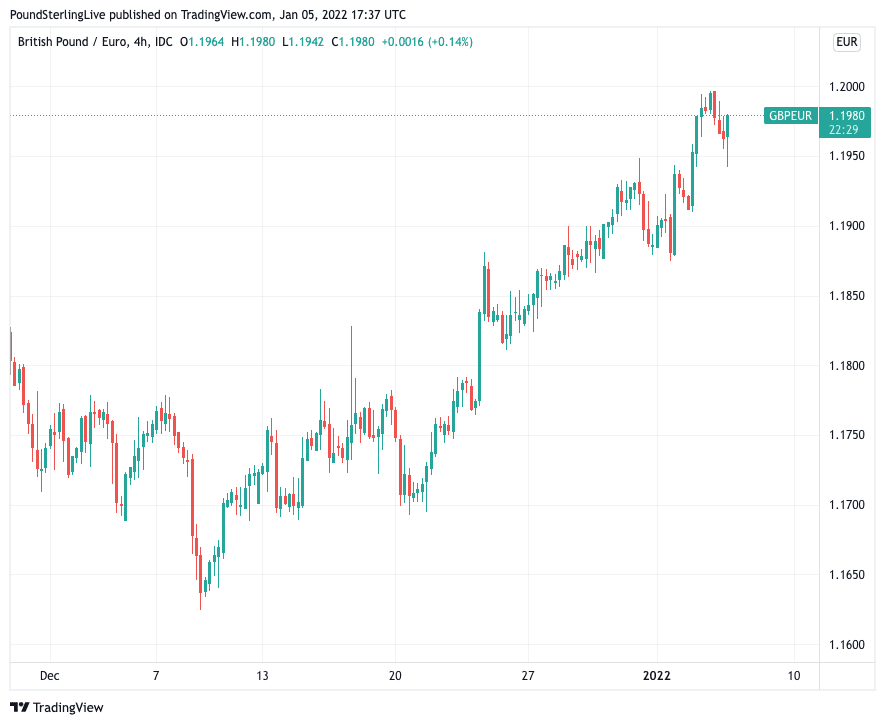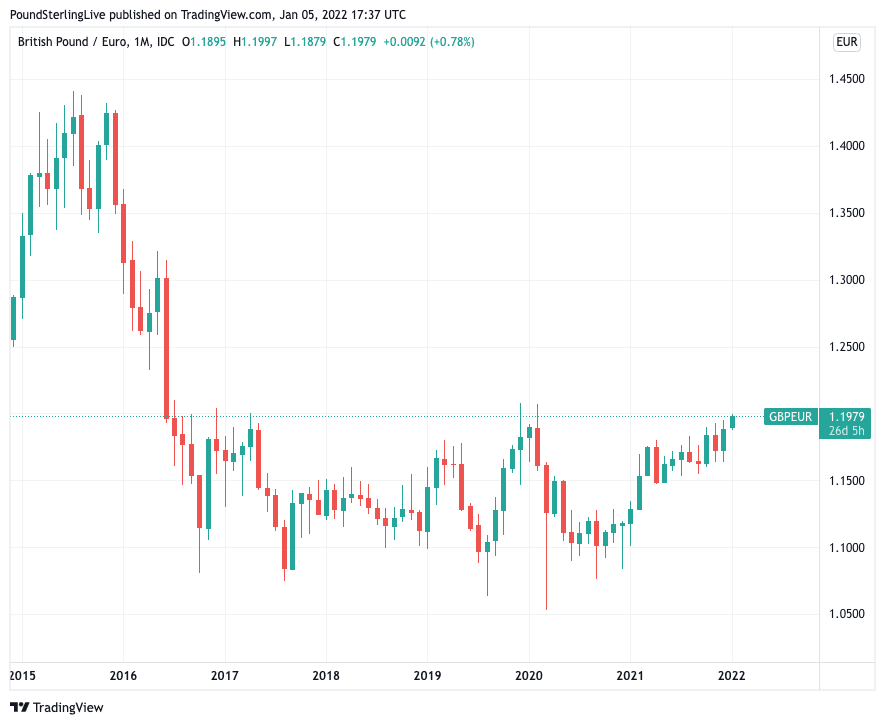Pound / Euro Faces Substantial Resistance in Approach to 1.20
- Written by: Gary Howes
- Sell orders could stymie GBP/EUR advance
- As two-year highs approach
- But break opens up some clean air
- Interest rate differentials favour GBP
- Path of least resistance is higher

Image © Adobe Images
Pound Sterling could be on course to test a pivotal two-year high against the Euro in coming sessions provided global market sentiment remains supportive and technical restistance around the €1.20 level melts away.
The Pound to Euro exchange rate reached a new 23-month high on Wednesday at 1.1997 and analysts say a test of the February 2020 highs could soon follow suit.
But a global market setback in response to the release of minutes from the U.S. Federal Reserve on January 05 added to near-term headwinds for Sterling against the Euro, Dollar and other major currencies and served as a reminder that foreign exchange rates never move in a straight line.
Stock markets retreated from recent highs and 'high beta' currencies such as the Pound pared gains after the Fed warned it would need to raise interest rates as soon as March, opening up the prospect of up to four interest rate hikes in 2022.
Sterling had been advancing ahead of the release of the minutes for the Fed's December meeting, amidst a decidedly more optimistic global investor landscape as traders shook the Omicron-related gloom that dominated the final weeks of 2021.
The markets were not expecting such a 'hawkish' tilt from the world's de facto central bank, raising expectations the era of 'easy money' is all but set to end in 2022.
Shahab Jalinoos, Global Head of FX Strategy at Credit Suisse, nevertheless says markets appear to have decided early in 2022 that "the 'omicron concern phase' which started in late November, to be largely over".
He says the focus for traders now will once again be on "wider global reflation hopes, especially in the context of current high realised inflation".
Jalinoos describes the Pound as a "pro-reflation" currency. "Conditions appear supportive for these types of currencies that represent conventional reflation stories," he says.
Since December 09 GBP/EUR has embarked on a near-uninterrupted rise that means it is close to testing the top of its post-Brexit range, just above 1.20.
Above: GBP/EUR since December.
- Reference rates at publication:
GBP to EUR: 1.1964 - High street bank rates (indicative): 1.1645 - 1.1730
- Payment specialist rates (indicative: 1.1856 - 1.1900
- Find out more about specialist rates and service, here
- Set up an exchange rate alert, here
But the presence of sell orders ahead of 1.20 could result in some substantial selling pressures as is often the case when this exchange rate encounters round numbers and the move could stall short-term.
"Human beings tend to pay attention to round numbers and treat them as special or more important than other numbers. This is good to know for traders because if you are rational, you can position yourself ahead of these round numbers knowing the probability of a fill is higher for a limit order at (for example) 68,998 than at 69,001," explains Brent Donnelly, CEO of Spectra Markets.
Given 1.20 has not been sustainably breached to the upside since 2013 the market looks set for an intriguing battle between sellers and buyers in early 2022.
"GBP/EUR continues to flirt with the €1.20 handle, which is over 8% higher than this time last year and over 5% higher than its 5-year average rate. GBP/EUR has closed the week out above the €1.20 mark just once since 2016," says George Vessey, a currency analyst at Western Union Business Solutions.
A break above 1.20 could open up some clear air that could allow for further gains to follow, meanwhile a failure could confine Pound-Euro to a range it has become familiar with since the Brexit referendum result of 2016:
Above: GBP/EUR performance since 2015.
Secure a retail exchange rate that is between 3-5% stronger than offered by leading banks, learn more.
Strategist Jeremy Stretch at CIBC Capital Markets says condition favour near-term gains by the Pound against the Euro, "ongoing monetary policy differentials favour EUR/GBP heading towards 0.8295 lows from February 2020." (GBP/EUR February 2020 high = 1.2055).
Whether the supportive fundamental impetus to the Pound's recent gains can last will however be the ultimate decider as to how the technical challenges GBP/EUR faces will resolve.
The UK currency is benefiting from a generalised improvement in global sentiment amongst investors, who appear less concerned about the spread of the Omicron variant than was the case prior to the Christmas break.
The 'high beta / risk-on' Pound tends to appreciate when stock markets are rising and investors are buying, and fall when the opposite is true.
"Along with global stock markets and improving global risk sentiment, the British pound has trended higher since the start of the year, despite record-breaking COVID-19 cases across the globe," says Vessey.
He says fears over the severity of the Omicron variant are receding, which is bringing the focus back to supply chain issues, inflation concerns, and the tightening of monetary policy by central banks.
"Sterling has risen against the euro on expectations of further UK interest rate hikes after December’s surprise rise from the Bank of England, while the European Central Bank is not expected to act on rates this year," says the analyst.
The UK is meanwhile unlikely to see any further restrictions imposed by the government to try and contain the spread of the virus, with Prime Minister Boris Johnson telling Parliament on Wednesday that no further lockdowns were likely.
"I think that life will return to something much, much closer to normality. It won’t be necessary to have the restrictions that we currently have in place. Business, investors will have all the confidence that they need," said Johnson.
He said he hopes that by January 26 the existing 'plan B' restrictions will expire.
{wbamp-hide start}
{wbamp-hide end}{wbamp-show start}{wbamp-show end}
Some economists we follow say the UK economy will shrink in the region of 1.0% during the December-January period as restrictions bite, consumers turn cautious and self-isolation rates rise, but they expect an economic rebound in February.
If this is a correct assumption then the Bank of England might raise interest rates again later in the month in an effort to constrain rising inflation rates that could breach 6.0% in the first half of the year.
Rising UK interest rates are meanwhile said by foreign exchange analysts to be a supportive driver of the Pound and given the European Central Bank (ECB) is still many months away from following suit.
For now then, the path of least resistance for Pound-Euro looks to be higher.







